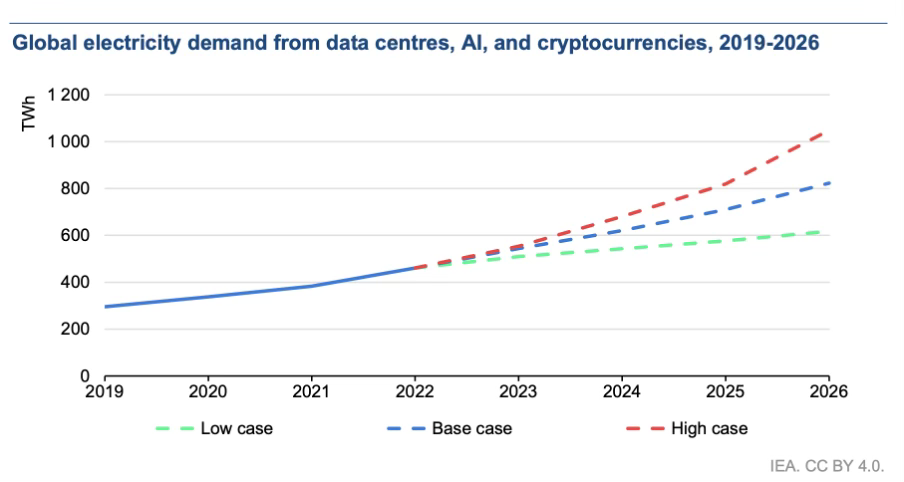Beyond the nuclear IT option
Nuclear power is being seen as a good sustainability option by big tech companies, but could subvert efforts to create a more energy efficient and sustainable industry

There’s been a lot of interest in the big tech companies investing in nuclear power to help meet the rising energy demands of artificial intelligence and data centres.
Microsoft is hoping it can help restart the Three Mile Island nuclear plant. Amazon Web Services is investing in small nuclear reactors, as is Google.
Some see this as a sign that big tech companies are revitalising the nuclear power industry when it was arguably on the point of going away. The World Nuclear Association (which has a nefarious James Bond vibe) reports that there are 440 power plants operating across 32 countries. Two thirds of these are over 30 years old, and many are expected to be decommissioned in the short- to medium-term. However, nearly 400 more are being planned or considered, mostly in Asia. North America may increase its nuclear power generating capacity by up to 48% by 2050 (relative to 2022), according to the International Atomic Energy Agency.
But tech companies are also using the choice of nuclear as a signal of good environmental responsibility because of the low carbon emissions. That’s an example of “carbon tunnel vision”, where only one sustainability-related issue is getting most of the attention. It encourages continued high energy use without providing a pathway to more efficient energy consumption and sustainable low environmental impacts.
In literary Arthurian terms, I see big tech companies pursuing an energy Beast Glatisant, chasing but never catching their energy quest while giving less attention to more important sustainability issues.
Rising energy consumption in the IT world
According to the International Energy Agency, data centres’ biggest electricity demands are computing (40%) and cooling (also 40%). IT electricity demand is anticipated to keep growing, fuelled by AI, cryptocurrency mining, and data centres.
IEA estimated that in 2022 data centres consumed 460 Terra Watts of power, about 2% of all global electricity usage.
Increased demand for IT-related energy is being driven not only by AI and crypto, but by increased adoption of 5G (and future) networks, more cloud-based services, and incentives by many countries or states for big tech companies to locate date and processing centres in their areas.
Semiconductor manufacturing facilities are also major energy users. A recent US report warns that bringing back such facilities to the US is increasing the use of “dirty energy” (fossil fuels).
Data centres and chip foundries are just another signal of the rapidly rising demand for electricity.
New nuclear
The nuclear power industry is going through a renaissance of sorts with a range of new designs. These are intended to be safer and more efficient, as well as smaller so they can be more quickly built and situated in more places. They are being strongly promoted as an always available low emission energy source to help move energy dependency away for oil, coal, and gas.
Small Modular Reactors can produce from tens of megawatts up to hundreds of megawatts and are able to be built in places not suitable for the large traditional nuclear plants (which can produce over 1,000 megawatts). There are no commercial models so far. The US government has invested $900 million in small nuclear reactors.
Nano Nuclear Energy promotes itself as being able to create portable “microreactors”, which could be shipped in following natural disasters such as hurricanes. It highlights what it calls its “walk-away safe” features, requiring little intervention. It may have a prototype before 2030.
Westinghouse is also developing a microreactor.
Will smaller and potentially more portable nuclear reactors have less oversight and security? Should there be more nuclear reactors in places with declining trust in authorities? There doesn’t seem to be much serious discussion of this within governments or the energy and tech sectors.
The nuclear industry is actively and effectively lobbying governments to change energy and climate policies to benefit the nuclear power sector, and delay the creation of fully renewable energy systems.
The nuclear lobby working with the big tech lobby creates a substantial risk of further retreats away from more environmental and social sustainability policies and initiatives.
Environmental, economic and social risks of nuclear energy
Some critics suggest that small reactors do not have the same economies of scale as traditional reactors, and so will be too expensive.
Be they large or small, nuclear reactors all produce radioactive waste. And a study published in the Proceedings of the National Academy of Sciences concluded that small nuclear reactors will increase the volume of nuclear waste more (2 to 30 times more) than large reactors. This is attributed to greater neutron leakage in small reactors, so creating more radioactive waste (such as steel).
Building safe repositories for nuclear waste is very challenging and expensive. It’s hard to find geologically stable sites away from people, water sources, and valued environments. The time frames needed to plan, design, and build them are exceptionally long. Considerable effort is also needed to build and maintain the trust of communities near these sites.
Proponents of nuclear power minimise the long-term costs too. A 2019 study by Barron & Hill, published in Energy Research & Social Policy, found that claims that nuclear power is a relatively inexpensive, low carbon, source of electricity are incorrect. This is because standard analyses focus more on short term costs and less on long-term, future generation, costs when considering nuclear waste disposal. In their models, which used more realistic discount rates for future costs, nuclear waste disposal was 2.5 to 4 times more expensive than other models have suggested.
“More realistic nuclear waste management cost models and uncertainty-appropriate intergenerational discount rates produce many more scenarios in which nuclear waste management costs are higher than previously assumed. As a consequence, nuclear energy’s economic attractiveness as a low carbon energy option appears to be lower than earlier works suggested.” Barron & Hill
Innovative Geothermal
An alternative to nuclear for a reliable weather-independent energy source is geothermal energy. This too is going through a period of renewed innovation.
Google is spreading its energy bets, using geothermal energy to power a data centre in Nevada.
The US Air Force is also looking at the same type of new geothermal energy - Geopressured Geothermal Systems – to see if it is suitable as a power source for Air Force bases. GSS uses fracking technologies to tap into deeper pockets of thermal energy, unlike traditional close-to-surface sources. Sage Geosystems is working with the Air Force to develop a demonstration plant. If successful and economic, geothermal energy could become more widely accessible.
In New Zealand, geothermal power is getting funding and technological boosts too. GNS Science is looking at tapping into “supercritical” geothermal just a few kilometres down. This seems to be trying the same or similar methods as GSS.
However, fracking in the oil and gas industry creates a variety of environmental problems. These include lots of wastewater, greenhouse gases such as methane, and air pollutants. And the potential for triggering small earthquakes (or large if you are drilling into a major fault line). There has been little discussion of environmental risks from GSS projects, but they likely to have some of the same problems.
Reducing energy demands
A focus on having a superabundance of energy (whatever their source) for data centres and semiconductor facilities can lead to the need for greater energy efficiency being minimized. More can be done to reduce energy demands. There are signs that this is occurring, though slowly and could quickly be reversed if energy becomes more accessible.
Nearly a decade ago Google proudly claimed that by using AI it had seen a 40% drop in the energy used to cool data centres. However, over the last five years its greenhouse gas emissions (an indicator of energy use) have increased by 48%, due to increasing use of AI.
Data centres have largely relied on air cooling. This consumes a lot of energy, and water. Liquid cooling methods with lower energy demands are used in some places. However, this requires lots of water, can be more complex, and may create significant environmental problems if there is a large leakage of coolants.
Immersing data centres in fluids (not just water) is another option but is costly and creates a new set of challenges.
Microsoft made a big splash seven years ago by putting a data centre 30 m underwater. After two years they pulled it up. While it appeared to work well Microsoft aren’t going to be sinking any more. However, a Chinese data centre company has created an underwater centre, and plans to submerge quite a few more. Nearly all the 11,000 data centres in the world though remain firmly on dry land.
A 2013 McKinsey & Co analysis found that semiconductor facilities were often overengineered, substantially increasing their energy needs. McKinsey suggested that by following the lead of other industries, semiconductor manufacturing processes could be quite easily redesigned to reduce energy usage by up to 30%. This advice doesn’t seem to have been widely adopted.
Now though, the US Department of Energy has worked with 65 IT-related organisations to develop a joint commitment to make semiconductor applications, including data centres, more energy efficient. The goal is to increase the energy efficiency of semiconductor applications 1,000-fold over the next 20 years. It’s only a commitment, with no agreed pathway to achieving it at this stage.
A common assumption currently is that AI models need to be massive to be effective, and therefore require lots of energy. However, some small AI models can be as good as massive ones, so energy needs could be significantly reduced without reducing effectiveness.
A longer-term possibility is doing data analyses with quantum computing. One suggestion is that less powerful quantum computers, equivalent to a modern-day supercomputer, could handle many AI, crypto, and data centre tasks using much less energy. Time will tell if this eventuates, but it is a weak argument to delay other changes in the hope that future technological developments will solve the problem for you.
Data Centres in Circular Economies
An emerging idea is that data centres, rather than being isolated energy hungry behemoths become integrated with other systems. For example, by utilising excess heat from the centres into agricultural production or household and commercial heating systems, or by using treated wastewater for cooling. Some are hailing this as data centres becoming part of the circular economy.
However, there seems a significant risk for gratuitous rebranding. Using excess heat to warm people’s houses is a good idea, but by itself it’s not circular. Circular economies need to be intentionally designed, rather than just opportunistic decisions for how to get rid of a heat or water problem. A data centre offloading excess heat but built with thousands of tonnes of concrete, and utilising lots of rare earth minerals (potentially acquired through environmentally and socially destructive practices) isn’t an example of a circular economy. The mining of the minerals, and their reuse after the data centre is finished with them, as well as the fate of the concrete, all need to be taken account of too.
Some of Microsoft’s data centres seem to be taking the circular challenge more seriously than other big tech companies at the moment.
Konietzko and colleagues have proposed a “minimum viable ecosystem for circularity” , which could be applied to big tech companies. This involves starting with a vision of circularity, a value proposition that makes that vision tangible, a governance model that can balance the different interests in the system and tracking environmental & social impacts.
We aren’t going to back away from a data intensive and algorithmic world. So we should be thinking more now about redesigning the systems for better sustainability and fairness and avoid being led astray by chasing mythical visions of abundant but potentially more dangerous energy options.


